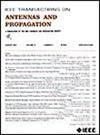Maximizing Independent Channels and Efficiency in BTS Array Antennas via EM Degrees of Freedom
IF 5.8
1区 计算机科学
Q1 ENGINEERING, ELECTRICAL & ELECTRONIC
引用次数: 0
Abstract
Massive multiple-input multiple-output (M-MIMO) technology has significantly advanced base station antenna design by integrating many transceivers (TRs) within antenna arrays, thereby improving network capacity and enabling the effective handling of complex multiuser scenario; however, antenna theory and antenna parameters with relevant bounds have not been adapted to this new reality. To address this gap, we propose a theoretical framework aimed at emphasizing the maximum number of independent MIMO channels that an antenna can provide in a cell and compare it with the physical upper bounds, and the latter is provided by the degrees of freedom (DoFs) of the field in the same cell. This approach allows for the definition of novel figures of merit for the quantification of antenna array performance, and the individuation of design strategies targeting the maximization of the number of independent channels, the average efficiency, and the maximum average gain within a specific cell. By exploring the DoF of the electromagnetic (EM) field, we establish the physical upper bounds for system performance. To this end, this article details the embedded element patterns (EEPs), their related efficiency correlation matrix (ECM) and cell correlation matrix (CCM), and orthogonal field modes, discussing the practical implications of these concepts for MIMO systems. The findings underscore the significance of sophisticated antenna models in enhancing network capacity, efficiency, and reliability. This article contributes to the optimization of antenna arrays in the next-generation mobile networks.利用电磁自由度最大化BTS阵列天线的独立信道和效率
大规模多输入多输出(M-MIMO)技术通过在天线阵列内集成许多收发器(TRs),从而提高了网络容量并能够有效处理复杂的多用户场景,从而显著改进了基站天线设计;然而,天线理论和具有相关边界的天线参数并没有适应这种新的现实。为了解决这一差距,我们提出了一个理论框架,旨在强调天线可以在小区中提供的独立MIMO信道的最大数量,并将其与物理上界进行比较,后者由同一小区中场的自由度(dof)提供。这种方法允许为天线阵列性能的量化定义新的优点数字,以及针对特定小区内独立通道数量最大化、平均效率和最大平均增益的设计策略的个性化。通过探索电磁场的自由度,建立了系统性能的物理上界。为此,本文详细介绍了嵌入式元件模式(EEPs),它们相关的效率相关矩阵(ECM)和单元相关矩阵(CCM),以及正交场模式,讨论了这些概念对MIMO系统的实际意义。研究结果强调了精密天线模型在提高网络容量、效率和可靠性方面的重要性。本文为下一代移动网络中天线阵列的优化提供了理论依据。
本文章由计算机程序翻译,如有差异,请以英文原文为准。
求助全文
约1分钟内获得全文
求助全文
来源期刊
CiteScore
10.40
自引率
28.10%
发文量
968
审稿时长
4.7 months
期刊介绍:
IEEE Transactions on Antennas and Propagation includes theoretical and experimental advances in antennas, including design and development, and in the propagation of electromagnetic waves, including scattering, diffraction, and interaction with continuous media; and applications pertaining to antennas and propagation, such as remote sensing, applied optics, and millimeter and submillimeter wave techniques

 求助内容:
求助内容: 应助结果提醒方式:
应助结果提醒方式:


